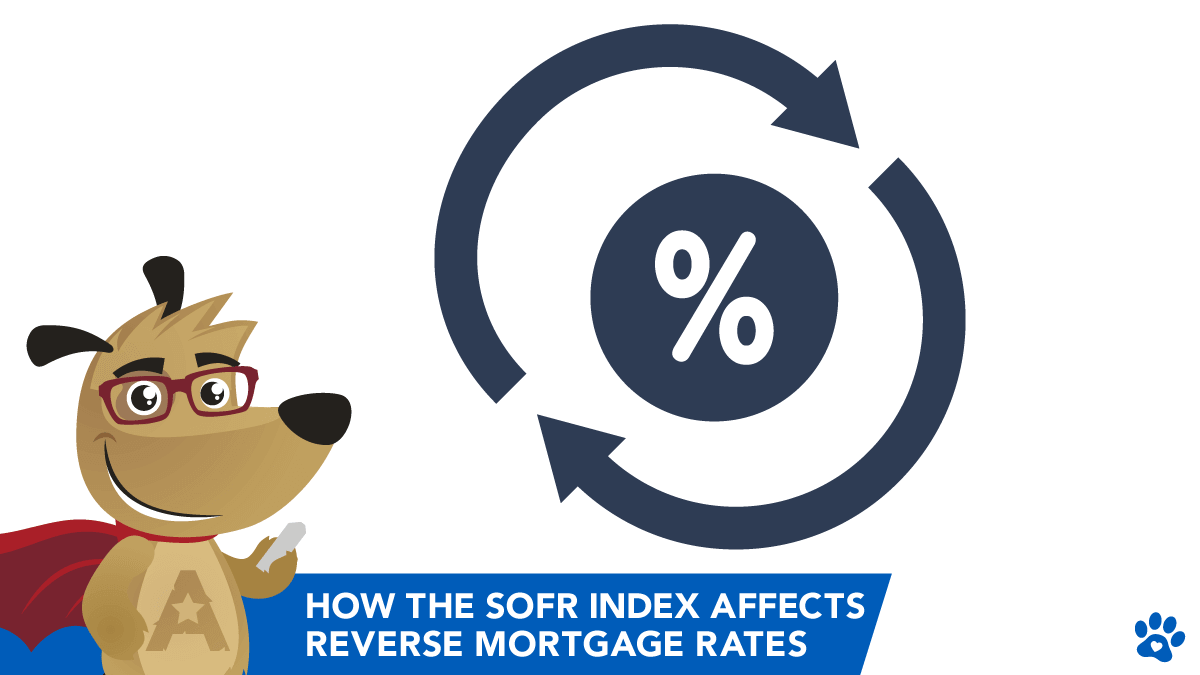
America’s #1 Rated Reverse Lender

 |
ARLO™REVERSE MORTGAGE
ASSISTANT |
How the SOFR Index Affects Reverse Mortgage Rates
 |
Michael G. Branson, CEO of All Reverse Mortgage, Inc., and moderator of ARLO™, has 45 years of experience in the mortgage banking industry. He has devoted the past 20 years to reverse mortgages exclusively. (License: NMLS# 14040) |
 |
All Reverse Mortgage's editing process includes rigorous fact-checking led by industry experts to ensure all content is accurate and current. This article has been reviewed, edited, and fact-checked by Cliff Auerswald, President and co-creator of ARLO™. (License: NMLS# 14041) |

For several years, adjustable-rate reverse mortgages used a variety of indexes that determined a benchmark interest rate, which, when added to a margin set by the lender, would determine the final interest that borrowers would accrue on their loan.
The rules for the choice of an index is that it had to be out of the lender’s control and had to be a readily published rate.
LIBOR history
Some of the more common indexes over the years include the U.S. Prime Rate, the various treasury-based indexes (MTA, CMT), the Cost of Funds Index (COFI), and the London Interbank Offered Rate (LIBOR), among others.
Adjustable rate reverse mortgage loans in the United States commonly used the CMT Treasury, Prime, and COFI indexes, but in an effort to gain broader international appeal for the mortgage-backed securities these loans were sold into, lenders began to switch to the more internationally accepted LIBOR index that was established in 1986.
HUD added the LIBOR to its list of acceptable indexes by final rule on July 7, 2007.
Fast forward to 2012, when it came to light that the LIBOR index had been manipulated by bankers at major financial institutions in London.
It has taken some time to find a suitable replacement for the LIBOR index since this revelation, but it appears that its replacement has been found in the Secured Overnight Financing Rat,e or SOFR.
SOFR affects all variable-rate reverse mortgages
Unless you received your loan before 2006, and you have an adjustable-rate loan, the LIBOR index was likely used to determine your interest rate.
Your loan documents also state that if the index ever goes away, the lender will need to replace it with a new index.
The new SOFR index that most lenders will be looking at is also a measurement of the short-term cost of borrowed funds, but it measures that cost more accurately and is much more difficult to manipulate.
The Urban Institute wrote in October of 2018 that the new index would likely lower rates to borrowers by .50% to .25% based on a study of historical rates comparisons which would be a great win for reverse mortgage holders.
We do not know all the answers yet, but we do know that the LIBOR index is due to be phased out by the end of 2021.
How the SOFR adoption will transition
It seems that one of the trickiest parts of the transitions now is that SOFR is a rate based on an Overnight Funding Rate and purely a daily rate.
Therefore, according to Morgan Stanley, determining a yearly index is not readily available currently.
There are also risk-based differences between the two indexes that would require adjustments, and according to Morgan Stanley, that’s where things will get complicated.
In the meantime, HUD and lenders are scrambling to resolve the questions as to how the transition to SOFR from LIBOR will take place.
What we can tell you at this time is that the change is coming, and it will affect all borrowers, both with forward and reverse mortgages, with LIBOR-index-based adjustable-rate loans.
While we cannot tell you exactly how the changes will occur yet, we can tell you, for the time being, it looks like it just may be a big win for reverse mortgage borrowers based on the information we have received so far.
Am I going to have a more undesirable index with the SOFR
Tom Wipf at Bloomberg says that there are many misconceptions about the fact that the Overnight Fund is such a short-term rate, making it undesirable as a LIBOR successor.
He states that since the SOFR is based on actual transactions instead of “expert opinions” or estimates (as is the LIBOR), the SOFR is much more accurate as a reflection of the market. And then, when you consider that the SOFR is averaged over actual market-based rates, the averages are quite stable.
In fact, he points out that the SOFR rose by half of the amount that the LIBOR did in September 2019 (the period shortly before his article).
He pointed out that most people cannot calculate the averages needed for the index presently, but that the Federal Reserve Bank of New York outlined plans to produce SOFR averages along with a SOFR index.
Once the SOFR averages are readily available, even new contracts using the current LIBOR index can begin referencing the fallback language issued by the ARRC (Alternative Reference Rates Committee convened by the Federal Reserve Board and the New York Fed).
For anyone really brave enough, you can read all about that on their site here.
What’s the bottom line
The bottom line is that no one knows for sure how all this will shake out yet. But the good news for borrowers is that if the rate is lower, as most predict, borrowers will incur less interest over the life of the loan.
The further good news is that it should not have any noticeable effect on most borrowers (other than an interest rate reduction).
That is, you won’t need to do anything. If you have a LIBOR-based adjustable rate loan, you will receive a notice from your lender that the LIBOR index is no longer available and that, pursuant to the terms in your agreement, your new index will be the SOFR.
Then, if all the financial “experts” are correct, life will go on just as it has, and then the only thing that will change will be positive.
After the way 2020 turned out, we could all use some positive results!
2022 Update: Ginnie Mae Publishes LIBOR Index Transition Reference Guide
Ginnie Mae published a LIBOR Index Transition Reference Guide to assist stakeholders in preparing for the transition away from the London Interbank Offered Rate to a replacement index between now and the LIBOR cessation date of June 30, 2023.
The Guide included sections on the HECM program that summarized what has been done thus far to begin the transition process. The Guide further noted, “A transition plan for legacy LIBOR HMBS is under analysis. No LIBOR transition policies with respect to legacy LIBOR HMBS have been released.”
2023 UPDATE:
The Department of Housing and Urban Development published a final rule today that replaces the London Interbank Offered Rate (LIBOR) as an approved index for new and existing adjustable-rate forward and reverse mortgages with the Secured Overnight Financing Rate (SOFR). The final rule will go into effect in 30 days.
ARLO recommends these helpful resources:

 Michael G. Branson
Michael G. Branson Cliff Auerswald
Cliff Auerswald

September 12th, 2023
September 14th, 2023